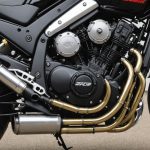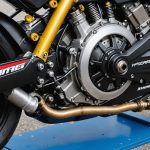Importance of Winterizing Your Sport Bike
Winterizing a sport bike is crucial for extending its lifespan, especially in the unpredictable UK climate. Harsh weather conditions can take a toll on the motorcycle’s components. Prolonging your sport bike’s life through proper maintenance is not only cost-effective but also ensures optimal performance when the riding season returns. The cold and damp UK winters can lead to corrosion, battery issues, and other performance hindrances.
Battery maintenance is a vital part of winterizing. Cold temperatures can decrease a battery’s efficiency and lifespan. Using a battery tender is recommended to keep the battery in optimal condition. This device ensures the battery remains fully charged during periods of inactivity, preventing the deep discharge that leads to capacity loss. A well-maintained battery means your bike is ready to hit the road as soon as spring arrives.
Also to discover : Comprehensive handbook for choosing and installing aftermarket frame sliders on uk sport motorcycles
Moreover, the UK climate, with its frequent rain and cold spells, necessitates additional precautions beyond just storing the bike. Ensuring proper protection against moisture and cold weather damage helps maintain your bike’s performance. Regular checks and timely interventions will help mitigate the impact of the winter months, preserving your sport bike’s condition year-round.
Step-by-Step Guide to Using a Battery Tender
When it comes to sport bike maintenance, ensuring your battery is in prime condition is crucial. A battery tender is an effective tool for maintaining battery life, especially in prolonging its usability. Here’s how you can ensure you’re using it correctly:
In the same genre : Discover top gear to elevate your cycling experience online
Selecting the Right Battery Tender for Your Sport Bike
It’s essential to choose a battery tender compatible with your sport bike. Examine your bike’s battery specifications before purchasing. Look for features like automatic charging and maintenance modes to prevent overcharging. These features contribute to efficient battery usage and long-term care.
Preparing Your Bike and Battery for Winter Storage
Proper preparation is key to maintaining battery health during winter storage. Start by removing any dirt or corrosion on the battery terminals. Ensure your bike is clean and dry — moisture can lead to long-term damage.
Connecting and Disconnecting the Battery Tender Correctly
Correct charging procedure safeguards your equipment. Attach the black clamp to the negative terminal and red to the positive. Ensure the battery tender is unplugged before making connections. After securely attaching, plug in the tender and let it maintain the battery. When disconnecting, always unplug first before removing the clamps. Taking these steps ensures a hassle-free maintenance experience.
Safety Considerations When Winterizing
Preparing your sport bike for the colder months goes beyond routine maintenance; battery safety plays a crucial role. Improper handling of the motorcycle battery can pose significant risks, including leakage or potential damage to electronic systems. Before you embark on the winter bike storage journey, ensuring the health of your battery is paramount.
Battery Health Check
Checking your battery’s condition is essential. Assess its charge level and examine any signs of damage. Replacing or repairing a compromised battery before winter can prevent unexpected failures when you need your bike most.
Safe Storage Practices
When it comes to storing your bike, adopting effective precautionary measures aids in prolonging battery life. Removing the battery and keeping it in a dry, cool place can reduce the risk of discharge or freezing. Invest in a quality trickle charger to maintain optimal charge levels over the dormant period. It’s these small steps that can save you considerable headaches in spring.
Additional Precautions
In addition to battery concerns, ensure your bike is thoroughly cleaned, lubricated, and shielded from potential moisture damage. Using a breathable cover can provide extra protection, helping maintain the bike’s pristine condition until you’re ready to ride again.
Common Mistakes to Avoid
It’s easy to fall into winter maintenance pitfalls when preparing your sport bike for the colder months. One common oversight involves misunderstanding how long to leave the battery tender connected. Keeping it attached for too long or not long enough can impact battery health, leading to battery damaging habits. A good rule of thumb is to follow the manufacturer’s instructions precisely to ensure optimal charging.
Furthermore, some riders focus solely on the battery, overlooking other essential maintenance tasks when winterizing. For example, neglecting to change oil, check tire pressures, or properly lubricate moving parts can lead to problems when spring arrives. Winterization should be a comprehensive process, encompassing all aspects of bike care.
Another frequent error is ignoring signs of battery or bike issues before storage. Symptoms like dimming lights or difficulty starting should be addressed immediately, not postponed until after the winter. By proactively addressing such issues, you can avoid complicated repairs and enjoy a smoother riding season.
In summary, avoid these pitfalls by being thorough and attentive in your sport bike care routine. Proper maintenance not only extends your motorbike’s life but also enhances performance when it’s time to hit the open road again.
Regional Factors Affecting Sport Bike Maintenance in the UK
Navigating sport bike maintenance in the UK is no small task, thanks to the unique weather conditions prevalent across the region. Understanding the influence of these conditions on maintenance routines is crucial for keeping your sport bike in top condition. In areas with frequent rain, for instance, ensuring your bike’s parts are well-lubricated is essential to prevent rust and corrosion.
The changing seasons also add complexity: wetter autumns and icy winters demand specific care. As the temperature drops, local biking community tips often include advice on winterizing your bike. Essential actions include adding antifreeze and checking tire pressure, which can decrease in cold conditions. This preparation protects your bike during inactive months and minimises issues when spring rolls around.
Different bike models have varied needs under UK weather conditions. For example, high-performance models with sophisticated electronics may require additional protection due to increased moisture sensitivity. Moreover, bikes with naked frames might demand extra cleaning and protective coatings to endure the elements. By accounting for these seasonal impacts and engaging with local communities, UK riders can maintain their sport bikes’ longevity and performance.











